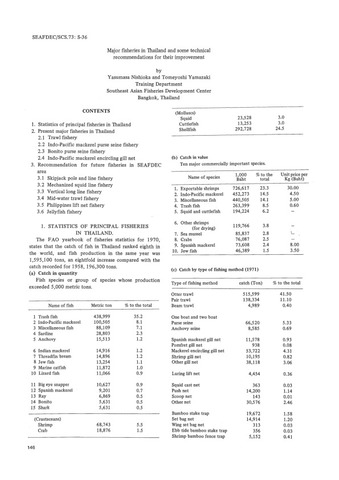| dc.contributor.author | Rajali, Hadil bin | |
| dc.contributor.author | Gambang, Albert Chuan | |
| dc.contributor.author | Hamid, Idris Abdul | |
| dc.contributor.author | Hassan, Raja Bidin bin Raja | |
| dc.contributor.author | Awang, Daud | |
| dc.contributor.author | Shiomi, Kunimune | |
| dc.contributor.author | Fujiwara, Shunji | |
| dc.date.accessioned | 2019-01-17T04:23:35Z | |
| dc.date.available | 2019-01-17T04:23:35Z | |
| dc.date.issued | 1999 | |
| dc.identifier.citation | Rajali, H. bin, Gambang, A. C., Hamid, I. A., Hassan, R. B. bin R., Awang, D., Shiomi, K., & Fujiwara, S. (1999). Stock assessment by hydro-acoustic method in the South China Sea Area II: Sabah, Sarawak, Brunei Darussalam. In Proceedings of the Second Technical Seminar on Marine Fishery Resources Survey in the South China Sea, Area II: West Coast of Sabah, Sarawak and Brunei Darussalam, 14-15 December 1998, Kuala Lumpur, Malaysia (pp. 338-352). Samut Prakan, Thailand: Training Department, Southeast Asian Fisheries Development Center. | en |
| dc.identifier.uri | http://hdl.handle.net/20.500.12067/826 | |
| dc.description.abstract | Acoustic resource surveys were conducted by M/V SEAFDEC off Sarawak, Brunei and the east coast of Sabah from July 10 to August 2, 1996 for pre-NE monsoon season and from May 1 to May 24, 1997 for post-NE monsoon season, using the scientific echosounder FQ-70, developed by Furuno Electric Co. Japan. Collected raw values of backscattering strength (SV) from the 200 kHz transducer were carefully corrected and filtered to eliminate the influence of plankton. These corrected SV values were divided into pelagic and demersal fish, and were used to estimate the biomass of pelagic and demersal multi-species in the limited coastal waters off Sarawak. Decapterus macrosoma for pelagic fish and Priacanthus macracanthus for demersal fish were selected as representative species, based on the fisheries statistics, landing place survey, and research vessel survey in order to estimate biomass. The standard length (SL) and weight of these representative species were obtained from research vessel survey and supported by previous literatures. Target strength (TS) of these representative species were calculated using formula TS = 20 log(SL) - 66. The distribution of the SV values for pelagic fish showed distinct difference between pre and post Northeast (NE) monsoon seasons along the coastal waters. Greater concentrations of SVs were observed from depth 100 and 200m on the continental shelf along the survey area for both the seasons. The estimated biomass of multi-species fish off coastal Sarawak waters for the pre and post NE monsoon seasons was 120,000 tonnes (100,000 tonnes of pelagic fish and 2x105 tonnes of demersal fish) and 470,000 tonnes (360,000 tonnes of pelagic fish and 110,000 tonnes of demersal fish), respectively. Estimated Maximum Sustainable Yield (MSY) was 83,000 tonnes for pelagic fish and 31,000 tonnes for demersal fish when using Cadima’s model. | en |
| dc.language.iso | en | en |
| dc.publisher | Training Department, Southeast Asian Fisheries Development Center | en |
| dc.subject | South China Sea | en |
| dc.subject | Malaysia | en |
| dc.subject | Sarawak | en |
| dc.subject | Sabah | en |
| dc.subject | Brunei Darussalam | en |
| dc.title | Stock Assessment by Hydro-acoustic Method in the South China Sea Area II: Sabah, Sarawak, Brunei Darussalam | en |
| dc.type | Conference paper | en |
| dc.citation.spage | 338 | |
| dc.citation.epage | 352 | |
| dc.subject.asfa | marine fisheries | en |
| dc.subject.asfa | pelagic fisheries | en |
| dc.subject.asfa | fishery surveys | en |
| dc.subject.asfa | stock assessment | en |
| dc.subject.asfa | demersal fisheries | en |
| dc.subject.asfa | echo surveys | en |
| dc.subject.asfa | fishery resources | en |
| dc.citation.conferenceTitle | Proceedings of the Second Technical Seminar on Marine Fishery Resources Survey in the South China Sea, Area II: West Coast of Sabah, Sarawak and Brunei Darussalam, 14-15 December 1998, Kuala Lumpur, Malaysia | en |



